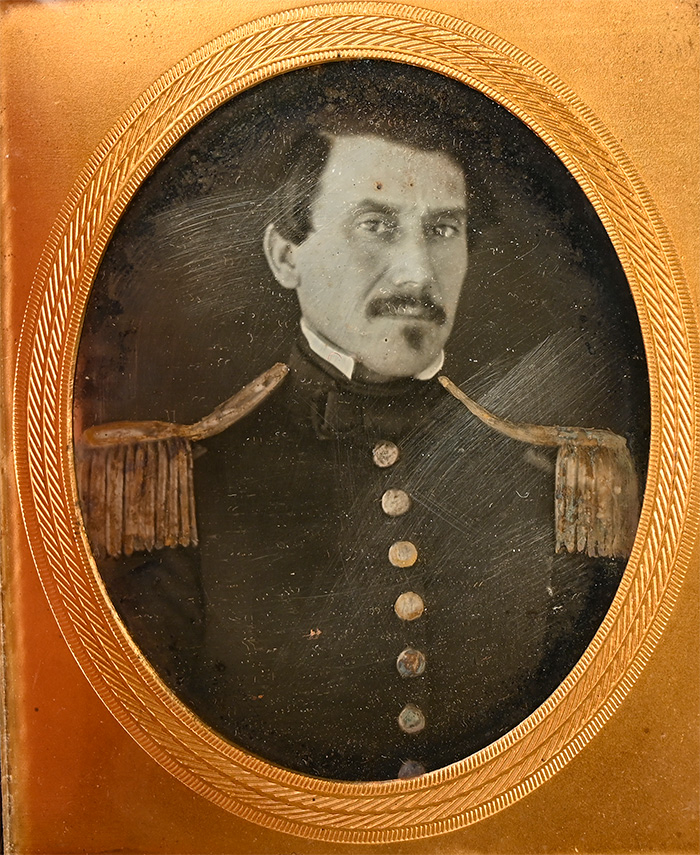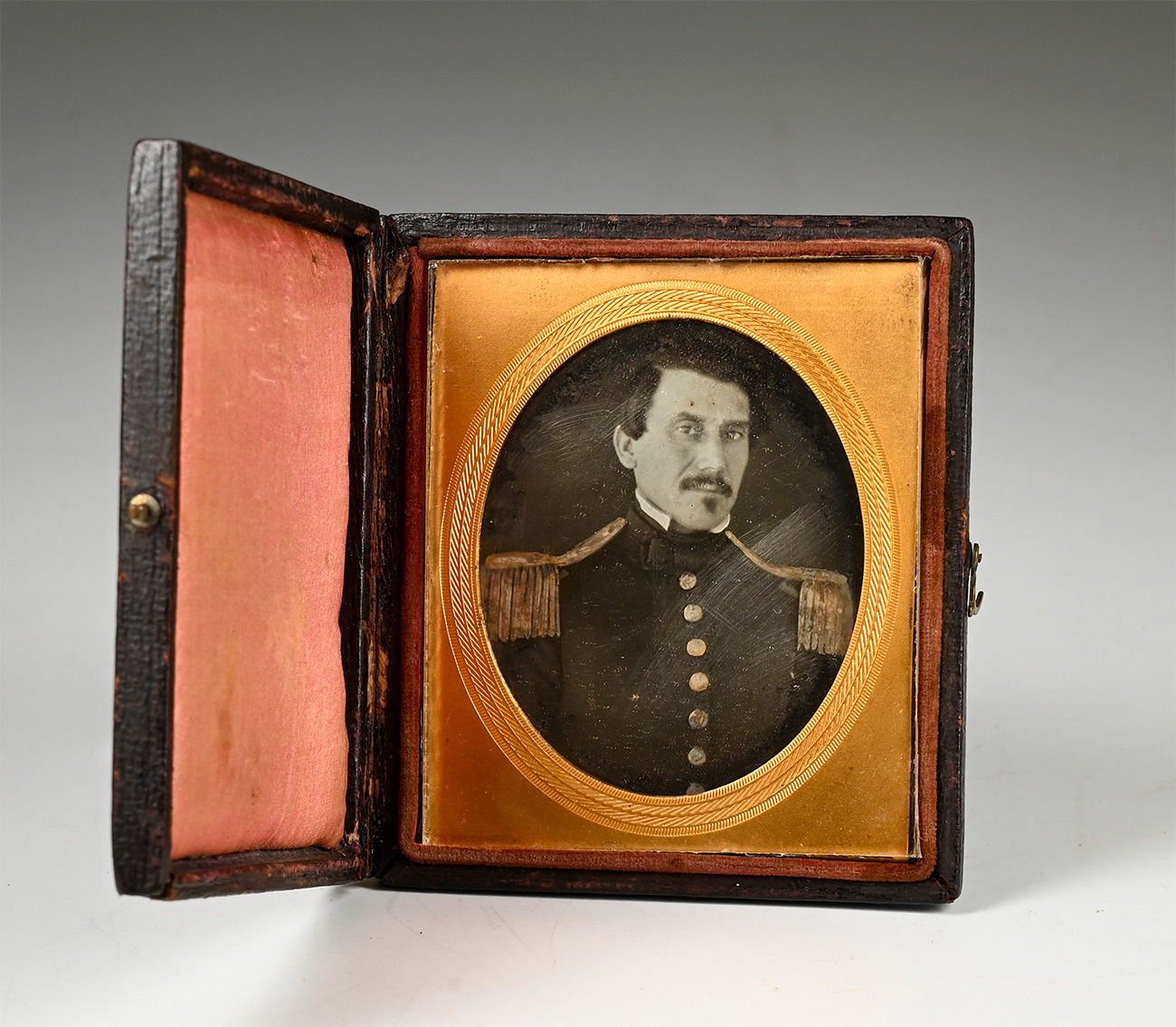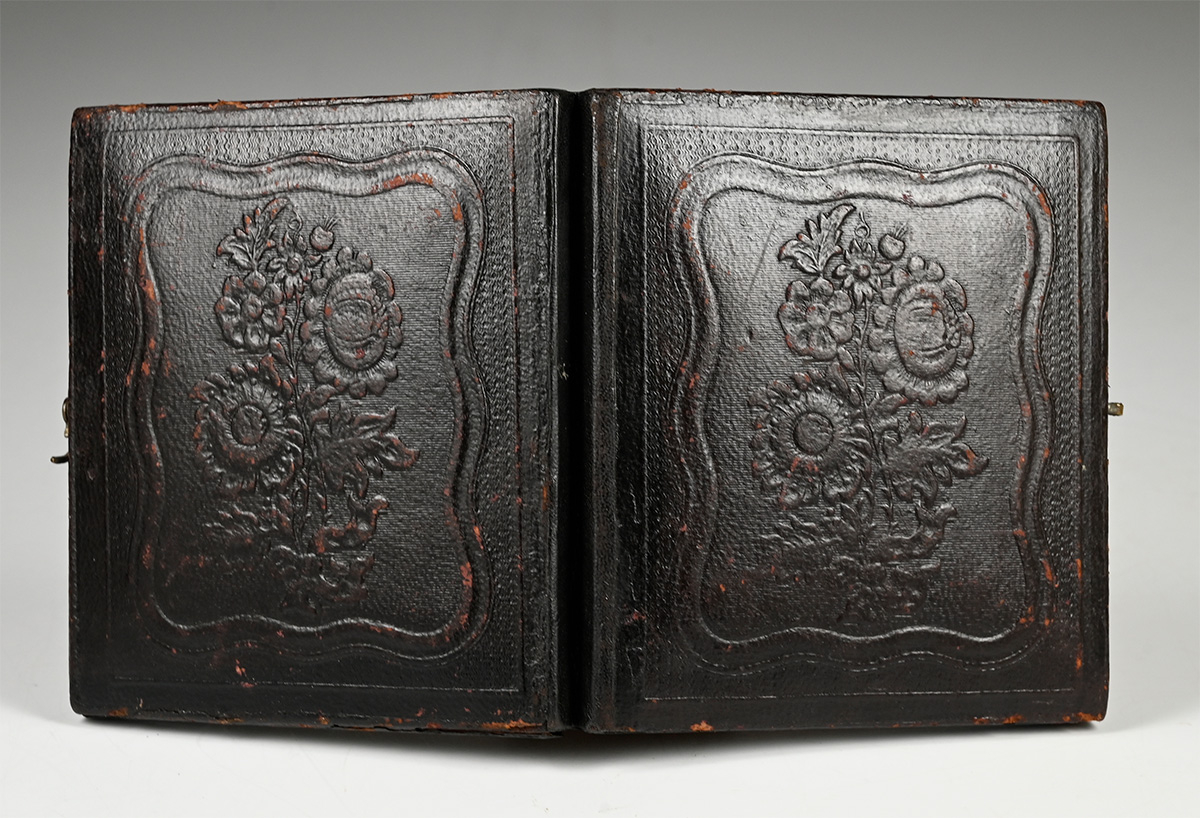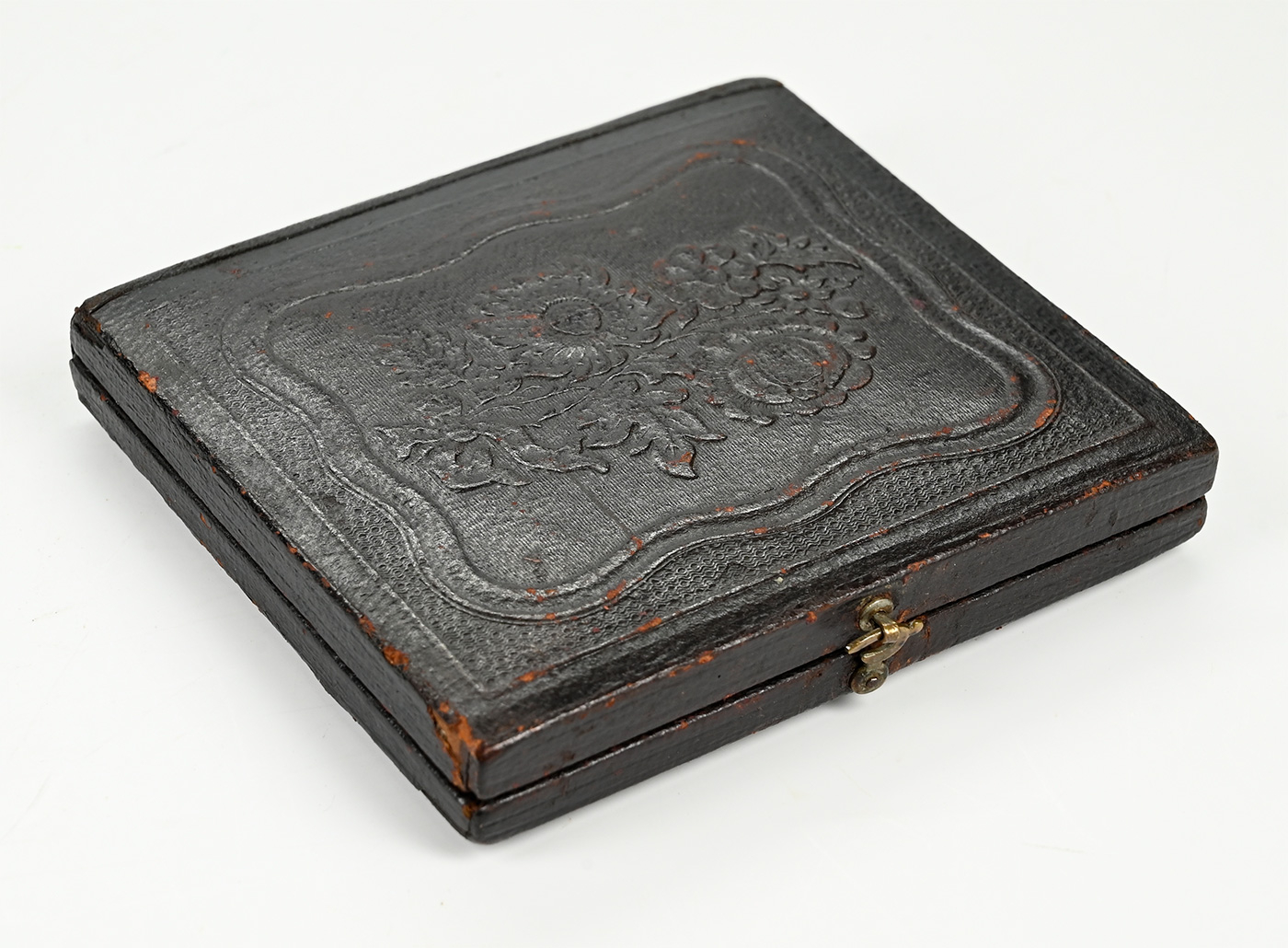site search
online catalog
DAGUERROTYPE IN UNIFORM OF LEWIS HENRY LITTLE, BREVET FOR GALLANT AND MERITORIOUS CONDUCT AT MONTEREY 1846; KILLED IN ACTION AS CONFEDERATE BRIGADIER GENERAL AND DIVISION COMMANDER AT IUKA 1862

Hover to zoom




$9,500.00
Quantity Available: 1
Item Code: 1138-1808
This very clear sixth-plate daguerreotype dates about 1850 and shows Lewis Henry Little, usually referred to by his middle name, as a Captain in the 7th U.S. Infantry. Born in Maryland in 1817, he was appointed 2nd Lieutenant in the 5th US Infantry in July 1839. He is frequently listed as a West Point graduate, but his commission seems to have been a direct one, likely through the influence of his father, a Colonel in the War of 1812 and several-term Congressman as Representative from Maryland. The younger Little transferred into the 7th Infantry in 1843 and served in that regiment until resigning from the U.S. Army 7 May 1861. He then served under Sterling Price, first in the pro-Southern Missouri State Guard, and then with a Confederate commission, commanding a brigade of Missouri Volunteers for Confederate service and later a division. He was a respected commander and was killed in action in September 1862 in the Battle of Iuka, Mississippi.
After transferring to the 7th U.S. Infantry in 1843, Little was promoted to 1st Lieutenant in 1845 and served with the regiment in Mexico, being brevetted Captain for “gallant and meritorious conduct” in the Battle of Monterrey on 23 September 1846. He served as regimental quartermaster from 31 March to 20 August 1847, when he was promoted to the regular rank of Captain. In addition to Monterrey the regiment saw action at Fort Brown, Vera Cruz, Contreras, Cherubusco and Chapultapec. They were afterward posted to Florida, Jefferson Barracks in Missouri, posts on the Arkansas frontier from 1851 to 1858, then back to Jefferson Barracks and service in Utah from 1858 to 1860, when they were sent to New Mexico. One source says that Little was in command of a post at Albuquerque when he resigned from the army 7 May 1861.
Little’s southern service began with an appointment in the Missouri State Guard as Colonel and Assistant Adjutant General on the staff of Sterling Price. References to him at that rank and post start on 18 May 1861 and stretch into early December, when he was given command of the new “volunteer corps,” that is: Missouri units going into Confederate service. This involved posting as Colonel of the 2nd Missouri, but put him in command of a “brigade” by January, though he was at that point only a Captain in the Confederate army. A promotion to Major seems to have caught up with him soon after. By late April he received a commission as Brigadier General.
His first combat experience as a brigade commander, however, had already taken place. Price had been forced out of Missouri, but in March commanded one of two divisions under Van Dorn at the Battle of Pea Ridge (Elkhorn Tavern) in Arkansas. The battle was a defeat for Confederate troops, but Little’s conduct earned praise, and perhaps his general’s commission. A secondary source says he became the de-facto commander of the entire division in the fighting. One of his staff officers (Schaumberg) wrote home shortly afterward, “He is now the acknowledged hero of the Missouri Army. After 22 years service in the United States Army he has an experience surpassed by none in the Army of the West, Cool Courage & Smart with the most unfounded confidence of his troops he always has the post of honor in battle, on the advance & on the retreat. T’was our Brigade which covered the retreat from Springfield Mo. T’was our lot to bear the brunt of the fight at Elk Horn both days & to us was given the guarding of the rear on the retreat from that place . . . I am proud to say that He was always foremost in the fight. It was my duty to be with him, side by side we rode thro the storm safely tho not quite soundly. For 52 hours I was in my saddle with only 1 hour & 15 minutes rest out of it!”
Van Dorn’s “Army of the West” was too late to join the attack on Grant at Shiloh, but joined Beauregard at the important rail junction at Corinth, Miss., afterward. There they took part in the month-long “siege of Corinth” that ended in May with Beauregard’s skillful pull-out before slow-moving Federal forces under Halleck could trap him. Van Dorn’s troops were only lightly engaged, but Little contracted malaria, which affected his health for the last few remaining months of his life.
Van Dorn and Price were then given separate districts to command. Price got the Army of the West as part of the District of Tennessee, covering northwest Mississippi and Northeast Alabama. Price consolidated the army into a single division under Little, consisting of four infantry and one cavalry brigade, and in September the two led it against the Union supply depot at Iuka, which they took on September 14 and halted to await Van Dorn’s forces for a united thrust toward Nashville. Five days later, on the verge of moving to rendezvous with Van Dorn, Price was attacked by a Union division under Rosecrans, which was immediately counterattacked by three brigades under Little. Confederates fought the Federals to a standstill and even took a battery of artillery in a charge, but in the course of the fighting Little was shot in the head and killed while consulting with Price.
Little’s body was taken to the rear and sent to his family in Maryland. The battle sputtered out with nightfall and before a second Federal column could join the attack the next day, Price withdrew to meet Van Dorn as planned. Little’s well-earned reputation as a battlefield commander has raised many “what-ifs,” especially since Price and Van Dorn met defeat shortly thereafter at Corinth. Several of Little’s diaries have been published, including the one found on his body after he was killed.
The image has nice tones and clarity. Little wears a regulation U.S. infantry officer’s frock coat with epaulets. The epaulets and buttons were lightly gilt, which has faded, and is not obtrusive though obscuring some details of the buttons. The image is housed in an early, simple leatherette case with plain silk facing pad and the plate is pressure-mounted with mat and glass, also suggesting an early date. Some old cellophane tape was used to replace the original seals and this should certainly be professionally resealed. This comes from the collection of well-known Virginia collector and dealer Bill Turner. He likely acquired it from the family. Little’s diaries have been published and contain several other images of him, but not this one. [sr] [ph:m]
~~~~~~~~~~~~~~~~~~~~~~~~~~~~~~~~~~~
THIS ITEM, AS WITH ALL OTHER ITEMS AVAILABLE ON OUR WEB SITE,
MAY BE PURCHASED THROUGH OUR LAYAWAY PROGRAM.
CLICK HERE FOR OUR POLICIES AND TERMS.
THANK YOU!
Inquire About DAGUERROTYPE IN UNIFORM OF LEWIS HENRY LITTLE, BREVET FOR GALLANT AND MERITORIOUS CONDUCT AT MONTEREY 1846; KILLED IN ACTION AS CONFEDERATE BRIGADIER GENERAL AND DIVISION COMMANDER AT IUKA 1862
Most Popular
Historical Firearms Stolen From The National Civil War Museum In Harrisburg, Pa »
Theft From Gravesite Of Gen. John Reynolds »
Selection Of Unframed Prints By Don Troiani »
Fine Condition Brass Infantry Bugle Insignia »
Large English Bowie Knife With Sheath 1870’S – 1880’S »
Imported (Clauberg) Us Model 1860 Light Cavalry Officer's Saber »
featured item
ID’D DRAFTING SET – THE FAMED “BOY COLONEL” HENRY BERGWYN – 26th NC, KILLED AT GETTYSBURG ON JULY 1
Henry “Harry” King Burgwyn, Jr. was known as the “Boy Colonel” because he attained that rank at the early age of twenty. He was perhaps the youngest colonel in the Confederate Army. Unfortunately, he never lived to see his twenty-second… (846-570). Learn More »


